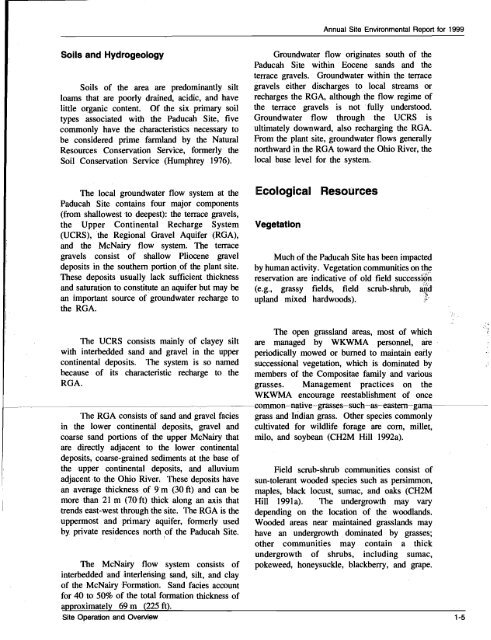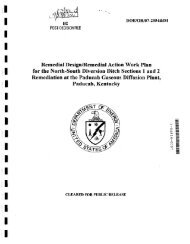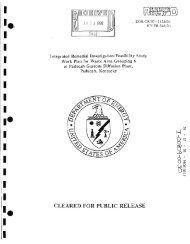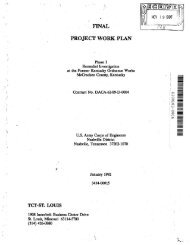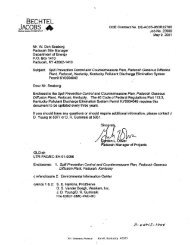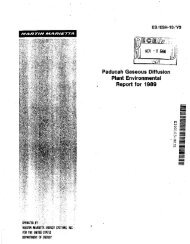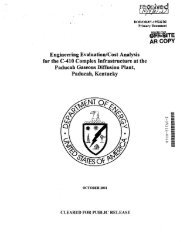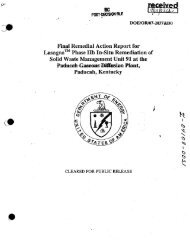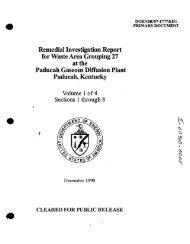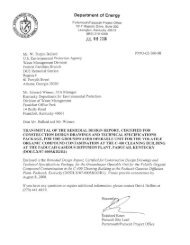1 - paducah environmental information center
1 - paducah environmental information center
1 - paducah environmental information center
You also want an ePaper? Increase the reach of your titles
YUMPU automatically turns print PDFs into web optimized ePapers that Google loves.
Annual Site Environmental Report for 1999<br />
Soils and Hydrogeology<br />
Soils of the area are predominantly silt<br />
loams that are poorly drained, acidic, and have<br />
little organic content. Of the six primary soil<br />
types .associated with the Paducah Site, five<br />
commonly have the characteristics necessary to<br />
be considered prime farmland by the Natural<br />
Resources Conservation Service, formerly the<br />
Soil Conservation Service (Humphrey 1976).<br />
Groundwater flow originates south of the<br />
Paducah Site within Eocene sands and the<br />
terrace gravels. Groundwater within the terrace<br />
gravels either discharges to local streams or<br />
recharges the RGA, although the flow regime of<br />
the terrace gravels is not . fully understood.<br />
Groundwater flow through the VCRS is<br />
ultimately downward, also recharging the RGA.<br />
From the plant site, groundwater flows generally<br />
northward in the RGA toward the Ohio River, the<br />
local base level for the system.<br />
The local groundwater flow system at the<br />
Paducah Site contains four major components<br />
(from shallowest to deepest): the terrace gravels;<br />
the VpperContinental Recharge System<br />
(UCRS),the Regional Gravel Aquifer (RGA),<br />
and the McNairy flow system. The terrace<br />
gravels consist of shallow Pliocene gravel<br />
deposits in the southern portion, of the plant site.<br />
These deposits usually lack sufficient thickness<br />
and saturation to constitute an aquifer but may be<br />
an important source of groundwater recharge to<br />
the RGA.<br />
The VCRS consists mainly of clayey silt<br />
with interbedded sand and gravel in the upper<br />
continental deposits. The system is so named<br />
because of its characteristic recharge to the<br />
RGA.<br />
The RGA consists of sand and gravel facies<br />
in the lower continental deposits, gravel and<br />
coarse sand portions of the upper McNairy that<br />
are directly adjacent to the lower continental<br />
deposits, coarse-grained sediments at the base of<br />
the upper continental deposits, and alluvium<br />
adjacent ,to the Ohio River. These deposits have<br />
an average thickness of 9m (30 ft) and can be<br />
more than' 21 m ('ZOft) thick along an axis that<br />
,trends east-west through the site. The RGA is the<br />
uppermost and primary aquifer, formerly used<br />
by private residences north of the Paducah Site.<br />
.. ,<br />
The McNairy flow system consists of<br />
interbedded and interletising sand, silt, and clay<br />
of the McNairy Formation. Sand facies account<br />
for 40 to 50% of the total formation thickness of<br />
approximately 69 m (225 ft).<br />
Site Operation and Overview<br />
Ecological Resources<br />
Vegetation<br />
Much of the Paducah Site has been impacted<br />
by human activity. Vegetation communities on the<br />
reservation are indicative of old field succession<br />
(e.g., grassy fields, field scrub-shrub, aild<br />
upland mixed hardwoods).<br />
l<br />
The open grassland areas, most of which<br />
are managed by WKWMA personnel, are<br />
periodically mowed or burned to maintain eady<br />
successional vegetation, which is dominated by<br />
members of the Compositae family and various<br />
grasses. Management practices on the<br />
WKWMA encourage reestablishment of once<br />
common-native-grasses-such-as-eastern-gama-----<br />
grass and Iridian grass. Other species commonly<br />
cultivated for wildlife forage are corn, millet,<br />
milo, and soybean (CH2M Hill 1992a).<br />
Field scrub-shrub communities consist of<br />
sun-tolerant wooded species such as persimmon,<br />
maples; black locust, sumac, and oaks (CH2M<br />
Hill 1991a). The undergrowth may vary<br />
depending on the location of the woodlands.<br />
Wooded areas near maintained grasslands may<br />
have an undergrowth. dominated by grasses;<br />
other communities may contain a thiek<br />
undergrowth of shrubs, including sumac,<br />
pokeweed, honeysuckle, blackberry, and grape.<br />
1-5


